What is Programmatic Advertising? The 2024 Guide
January 25, 2019
The numbers don’t lie.
A report published in April of 2022, stated that the Programmatic Ad Market was worth $136 billion in 2021, making up about 90% of all digital display marketing.
So why do advertisers increasingly turn to programmatic for their display campaigns, and what is it really?
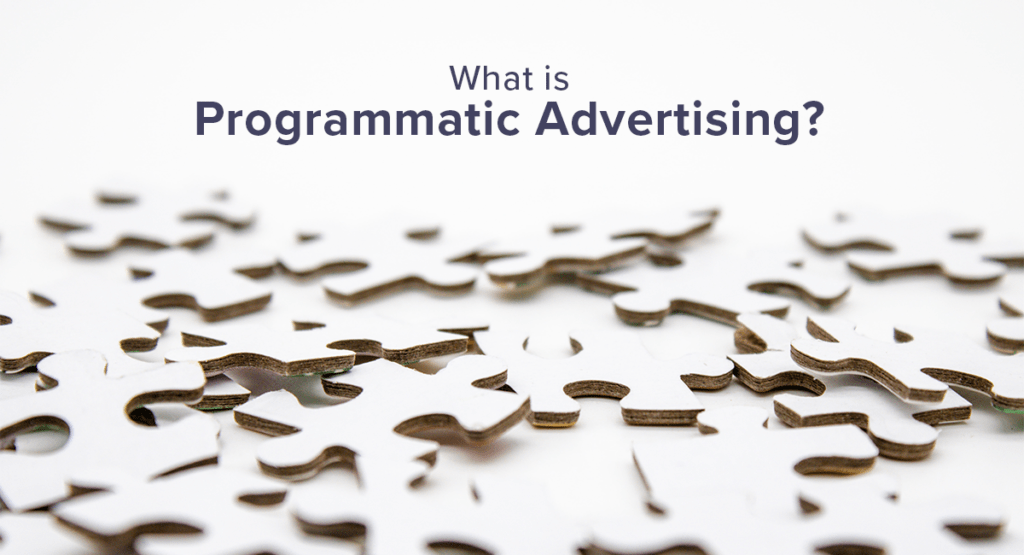
Briefly put, programmatic advertising is a way to automatically buy and
It’s designed to replace human negotiations with machine learning and AI-optimisation. The goal is to increase efficiency and transparency for both the advertiser and the publisher.
This is done through real-time auctions where ads are bought at the same as a visitor loads a website.
If you’re interested in learning more about programmatic and how it works – this is the article for you!
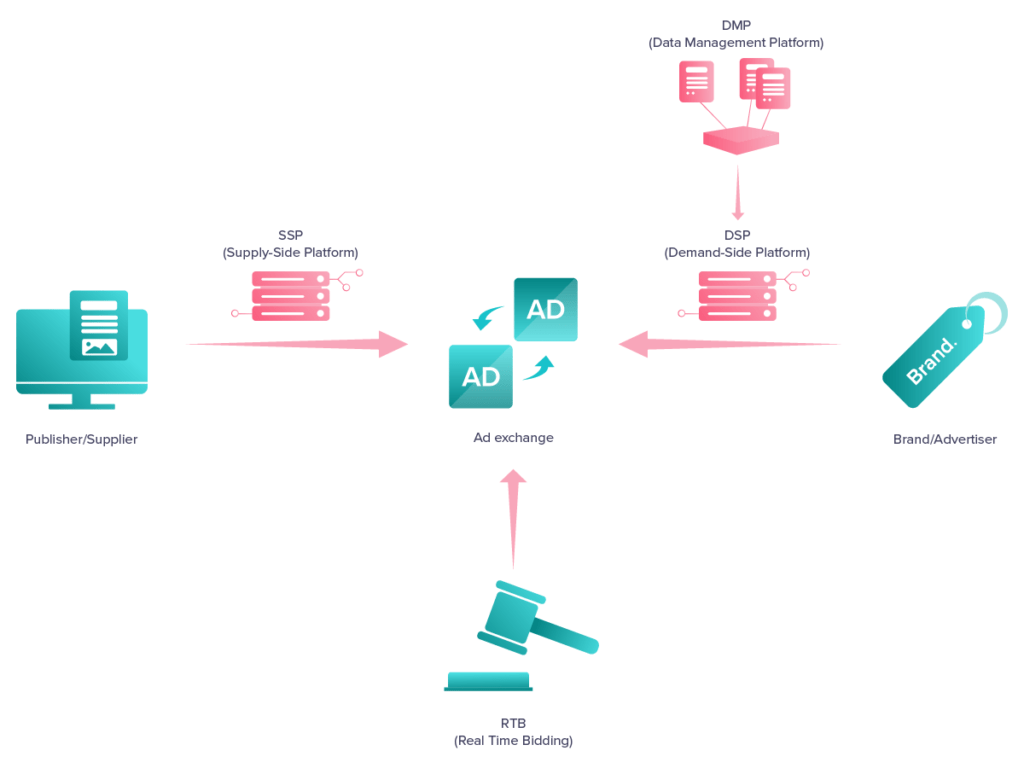
Content
Who uses programmatic?
Programmatic advertising exists in a wide range of digital channels, including display, mobile, video, and social.
Traditional offline channels are well on their way to becoming digitized too.
We’re starting to see out-of-home channels advertise programmatically through digital screens on bus stations, shopping malls, and billboards. Connected TV (CTV) is also one of the fastest growing trends within programmatic media.
Previously, programmatic campaigns has been reserved for larger budgets and media agencies, but the rapid rise of self-service tools (like Match2One) gives smaller brands increased access to the technology and offers them the ability to compete with larger brands without going through expensive middlemen.
The Definition of Programmatic Advertising
The use of Artificial Intelligence and machine learning to buy advertising in real-time, instead of going through human negotiations and pre-set prices.
A brief history of display advertising and the rise of programmatic
The first-ever online ad ran all the way back in 1994 on what is now Wired Magazine, but was then HotWired.com, and featured a banner from AT&T.
This display ad was revolutionary in its time but would today be considered bad practice. Here it is:

In these early days of digital marketing, ads were traded in much the same way you’d buy a regular magazine ad.
Salespeople would reach agreements with advertisers to place a banner on a website for a specific time period. This meant the same banner
The first central ad server, which allowed salespeople to sell ads on multiple websites, was created in 1995.
This meant you could, for instance, choose to show your ads across multiple news websites owned by the same company.
One of the first ad servers was DoubleClick, which was purchased by Google in 2007 for $3.1 Billion.
It’s still active today but has now been merged with Google’s marketing brand Google Marketing Platform.

In the early days, the number of publishers grew quicker than the number of advertisers – meaning there were more websites available than people willing to advertise on them.
This left publishers with an oversupply of ad space, and large quantities of unsold inventory.

As a solution to this, ad networks were created. They are platforms that pool unsold ad space from several publishers and make it available to advertisers at a discounted rate.
Sort of like shopping from the discount bin at the store.
Premium inventory was still handled manually on a case-by-case basis, but the leftovers were auctioned off to the highest bidders.
The problem with this approach was targeting.
If you chose to advertise on a large publisher’s website there was no way of knowing who saw your ads.
Products aimed at an audience of, say, people over the age of 50 could just as well be shown to 25 year-olds.
This brought on the birth of Real-Time Bidding (RTB) – the first real instance of programmatic advertising.
To learn more about Real-Time Bidding, keep reading!
What is Real-Time Bidding (RTB)?
RTB is a way of buying and selling ads through real-time auctions, meaning transactions are made in the time it takes to load a webpage; around 100 ms.

It works like this:
As a visitor enters a website, a request is sent to an ad exchange with information on the website along with visitor data.
This information is then matched against available advertisers and a real-time auction takes place between the advertisers that match the criteria.
For instance, let’s say you visit a website that sells organic dog food, but you don’t make a purchase. Later you visit your favorite news site, and suddenly you see ads about organic dog food everywhere!
These ads are placed in front of you with the help of Real-Time Bidding.
The company selling dog food has simply stated: “I want to show my ads on these websites – but only to visitors who previously visited my site and didn’t make a purchase.”.
During the time it takes you to load the website an auction takes place between the organic dog food brand and everyone else who’s also interested in showing you ads.
The winning bidder gets to display its ad to you on the publisher’s website.
Historically, advertisers would place ads on websites they believed matched their target audience – so a company selling motorcycle helmets would maybe single out blogs about motorcycles, and manually buy placements on these sites.
Their banner ads would then be displayed to all visitors of that website, regardless of whether they’re relevant customers or not.
Real-Time Bidding allows for better and quicker targeting, enabling ads to be bought and sold on a per-case basis, meaning only visitors who are in your target audiences will be subjected to the ad.
For instance, a user might have previously visited a site that sells motorcycle helmets, and would, therefore, be a more relevant target for a helmet ad.
The advertiser would then increase the bid for these visitors, perhaps even outbidding large multinational brands. This type of real-time media buying was the beginning of programmatic technology.
Is Real-Time Bidding a form of Programmatic Buying?
Yes, RTB is a form of programmatic advertising, but not all programmatic is through Real-Time Bidding.
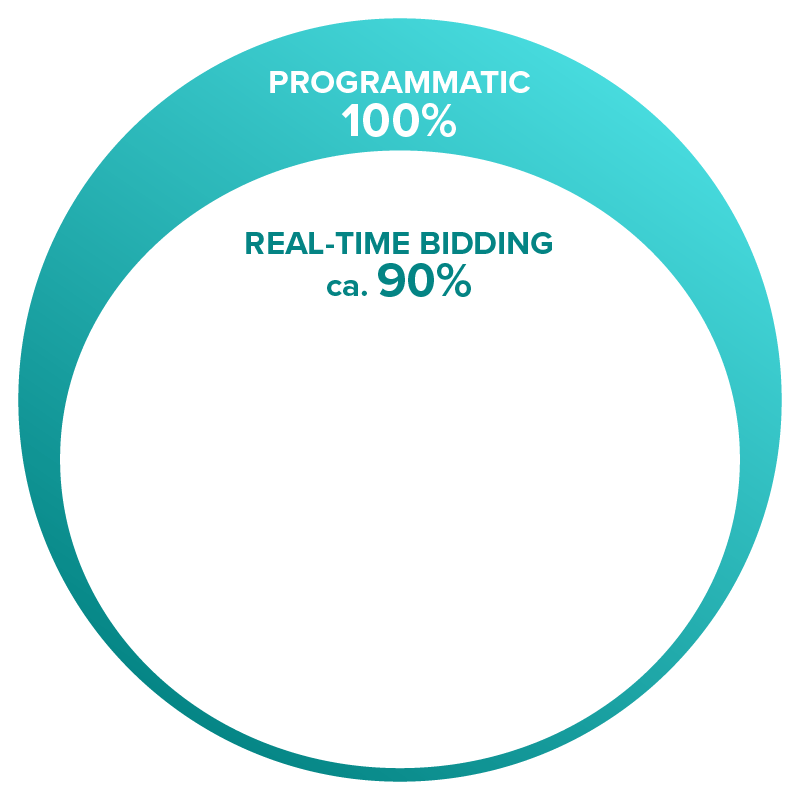
Programmatic advertising technology is simply a way to automate ad buying, and RTB is one way this can be done.
Even though roughly 90% of programmatic buying goes through Real-Time Bidding, there are other ways of programmatic advertising, namely;
- Programmatic Direct
- A way to buy a guaranteed amount of impressions on specific sites.
- Usually used for large “premium” formats like full-page takeover ads
- Often involves a fixed-price agreement rather than an auction
- Private Exchange buying (PMP)
- An invitation-only marketplace where one or a select number of publishers invite specific advertisers to bid on their inventory space.
- Used as a way of bypassing ad-exchanges altogether, where your buying platform plugs directly into the publisher’s inventory.
- An auction usually takes place, but the terms of the deal are pre-negotiated, creating a more manual environment than regular RTB.
So what exactly is the difference between RTB and Programmatic?
Real-Time Bidding is just one part of the digital marketing ecosystem.
It’s a way of auctioning out ad space on a case-by-case basis rather than a carpet-bombing approach where everybody sees the same ad.
For a programmatic system to work properly there needs to be other key components in place.
On the advertiser’s side, this would be a Demand-Side Platform (DSP), connected to a Data Management Platform (DMP).
Suppliers (publishers) use a Supply-Side Platform (SSP) to distribute their available inventory across one or multiple Ad-Exchanges.
That’s a lot of terms to keep track of, but don’t worry. If you keep reading you’ll find out what they mean!
What is an Ad Exchange?
An Ad Exchange is where publishers meet advertisers and agree on a price to display their ads.
It functions much like the trading floor of a stock market, but for digital display advertising.
Nowadays, most ad exchanges operate through real-time auctions, where an ad purchase is made at the same time as a visitor loads a website.
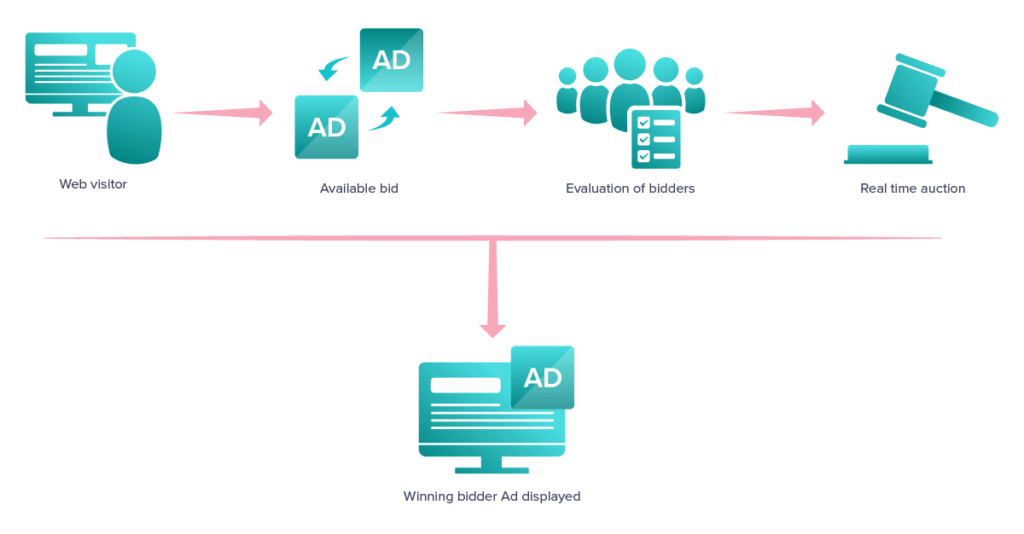
The ad exchange sits in the middle of the programmatic ecosystem and is plugged into a Demand-Side Platform (DSP) on the advertiser’s side and a Supply-Side Platform (SSP) on the publisher’s side.

What is the difference between an ad network and an ad exchange?
An ad network is a platform that’s connected to a certain number of websites, and offers inventory for advertisers on those sites, whereas an ad exchange is a trading floor where advertisers can buy ad space from multiple ad networks.
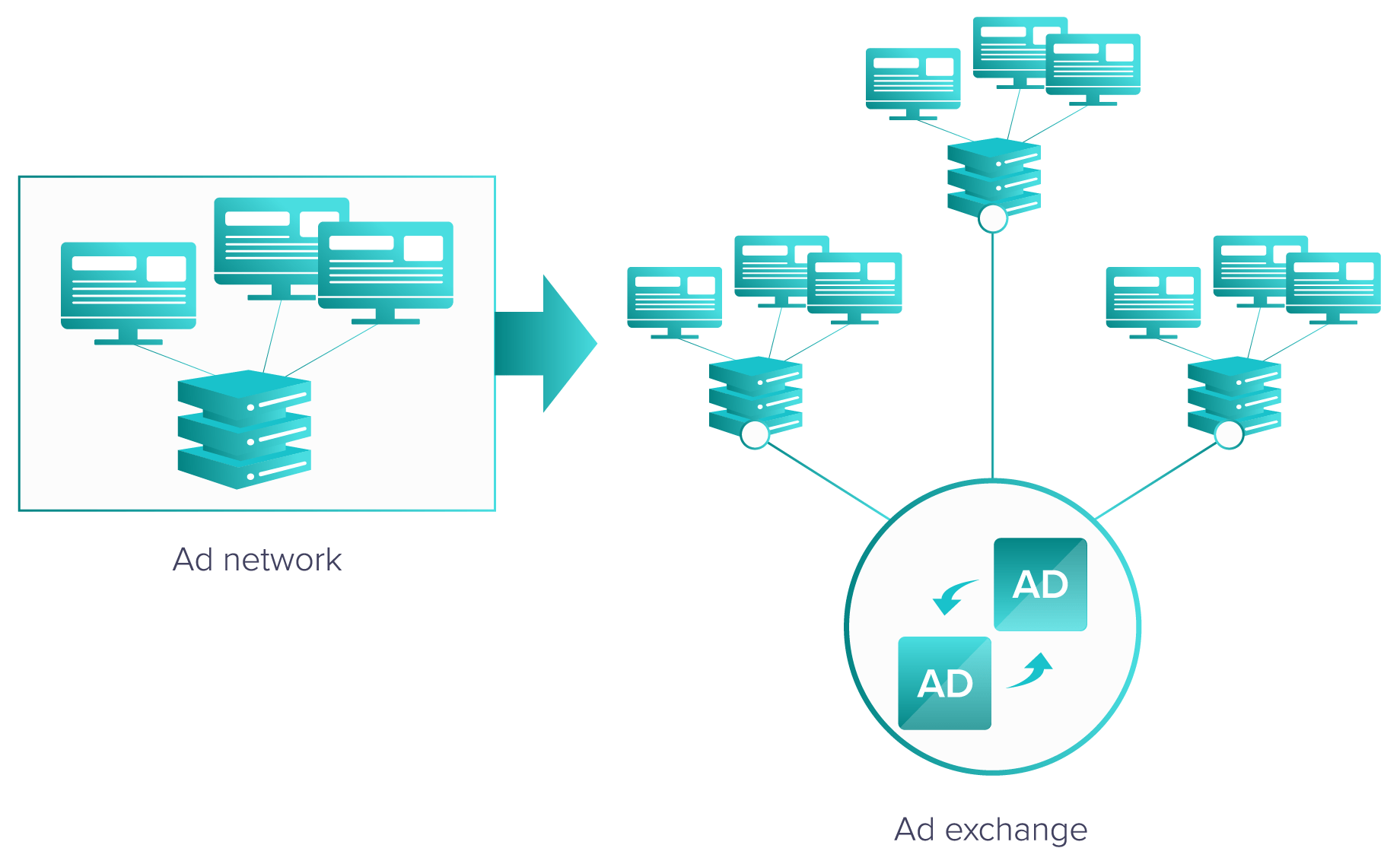
Ad exchanges have traditionally been used as a way for publishers to auction off unsold inventory to the highest bidder, after having sold their premium inventory manually.
You’d simply throw your leftover space in a pool of other leftover space and hope someone bought it.
The rapid growth of programmatic ad buying has increased the relevance of ad exchanges, since most advertisers have seen the benefits of better targeting and real-time auctions.
Top ad exchanges 2021
There are numerous ad exchanges for publishers and advertisers to connect to. These are the biggest ones:
- Xandr
- AOL’s Marketplace
- Microsoft Ad Exchange
- OpenX
- Rubicon Project Exchange.
- Smaato
- DoubleClick, was acquired by Google in 2008.
Mobile Ad Exchanges
Nowadays most ad exchanges also handle mobile inventory, since mobile is such a large part of the digital advertising landscape – but there is one Twitter-owned platform that focuses exclusively on in-app advertising.
This platform is called MoPub.
Ad exchange vs DSP
An ad exchange needs data to know which bidders qualify for certain websites and audiences.
This is managed by Demand-Side Platforms (DSP’s) and Supply-Side Platforms (SSP’s).
A DSP is what advertisers use to let an exchange know what they have to offer.
Want to know more about DSP’s? Read on.
What is a Demand-Side Platform (DSP)?
A demand-side platform is a tool or software that allows advertisers to buy ad placements automatically.
Historically, as more and more publishers offered advertising possibilities online, advertisers needed a way to manage placements and purchases automatically rather than dealing with salespeople and trading desks.
Many found these manual methods both expensive and unreliable – and DSP’s (like Match2one) help solve that problem.
How does a DSP work?
An advertiser signs up with a DSP, which in turn is connected to an ad exchange.
The ad exchange is where the actual buying and selling of ads and inventory takes place.
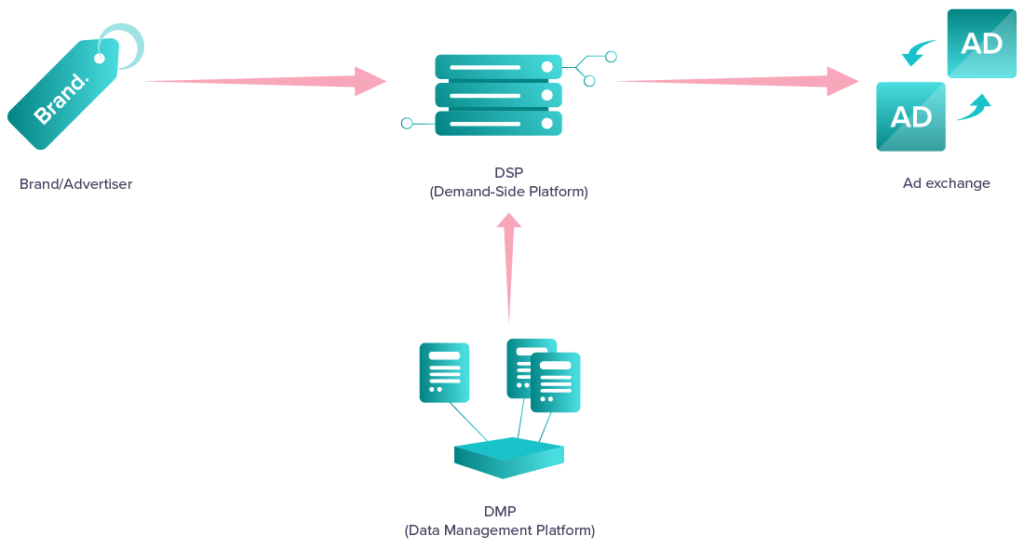
When a visitor reaches a website that’s connected to the ad exchange, an auction signal is sent to the exchange.
The exchange then asks the DSP if the advertiser has any ads that might fit the placement.
If it does, the DSP sends a signal to enter a real-time bidding auction together with other advertisers to compete over the placement.
The winning bidder gets to show his ad to the website visitor.
This is the foundation of programmatic marketing on the advertiser’s side.
What is the difference between a DSP and an SSP?
A DSP and an SSP simply connect to different parts of the programmatic ecosystem.
A Demand-side Platform (DSP) is the advertiser’s tool to help
Mobile DSP
Most DSP’s today can handle both mobile and desktop inventory. There are ad formats that do very well both on mobile and traditional displays.
You can learn more about the most popular banner formats in this post, but the main one to keep in mind is:
- 300×250 Medium Rectangle Ad
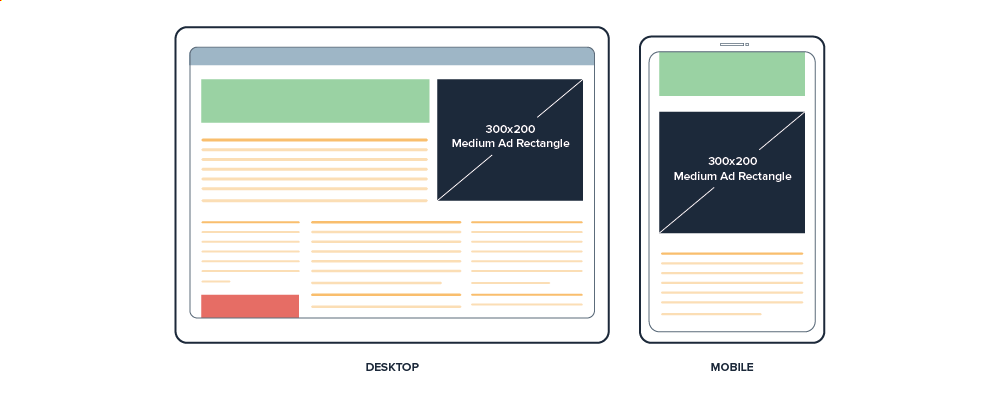
This one banner size makes up 40% of all display advertising impressions and works well both on mobile and desktop.
Is Google Adwords a DSP?
Technically, yes, Adwords (or Google Ads as they’re now called) is a type of Demand-Side Platform – but it’s only limited to Google’s inventory.
Even though the Google Display Network has access to a large percentage of the world’s websites, there are places where they have no reach.
One of the main benefits of using a 3rd-party self-service programmatic DSP is you get access to inventory that isn’t covered by Google’s ad network.
Facebook display ads, for instance, are not part of Google’s ad inventory.
This means if you run your campaigns through the Google Display Network they will not be displayed on Facebook.
As an advertiser, you’d generally want to have access to as much inventory as possible.
Especially when running programmatic advertising campaigns, since this increases your chances of finding profitable placements.
With Match2One you get access to the Google Display Network – but also other ad networks like AppNexus, that might find you more profitable placements.
What is a Supply-Side Platform (SSP)?
In much the same way advertisers use Demand-Side Platforms to manage their programmatic ad buying, publishers use a Supply-Side Platform to manage their display space.
What was previously a manual process where each publisher would have salespeople responsible for reaching out to advertisers and selling ad space has now been automated by Supply-Side Platforms.
The SSP connects to an ad exchange and tells it what kind of inventory is available – and through Real-Time Bidding this inventory is automatically auctioned off to the highest bidder.

Of course, a DSP’s job is to buy programmatic ad space as cheaply as possible from publishers, but an SSP has the opposite function – selling ad space for the highest possible price.
An SSP can connect to several different ad exchanges in order to maximize the publisher’s exposure to potential buyers.
Through an SSP a publisher can also control inventory in a more efficient way; you can set minimum prices and dictate specific buyers or specific channels.
Which are the top SSP’s in 2021?
Many DSP’s also manage Supply-Side Platforms. These are the top 10 SSP’s on the market right now, according to g2crowd:
- AerServ
- Xandr
- DoubleClick for Publishers
- BrightRoll Ad Exchange
- MoPub
- OpenX
- ONE by AOL
- PubMatic
- Rubicon Project, For Sellers
- ADYOULIKE
- SmartyAds SSP
Ad exchange vs SSP
SSP’s are, among other things, used to distribute inventory across multiple ad exchanges – so a publisher connects his website to an SSP and tells it I have these placements and formats available, and the SSP connects that inventory to one or several ad exchanges.
How much does an SSP Cost?
All Supply-Side Pl
An average fee would typically be around 10-20% – with additional charges for things like Data Management Platforms and programmatic functionalities.
It’s important to know what you want to get out of your SSP before committing to one. Do you need programmatic features? What kind of targeting options do you want?
Once you know what you need – start shopping around from the list above!
What is a Data Management Platform (DMP)?
A data management platform is used to collect, store and sort information.
In programmatic, DMP’s are most often used in combination with a Demand-Side Platform on the advertiser’s side – or a Supply-Side Platform on the publisher’s side.
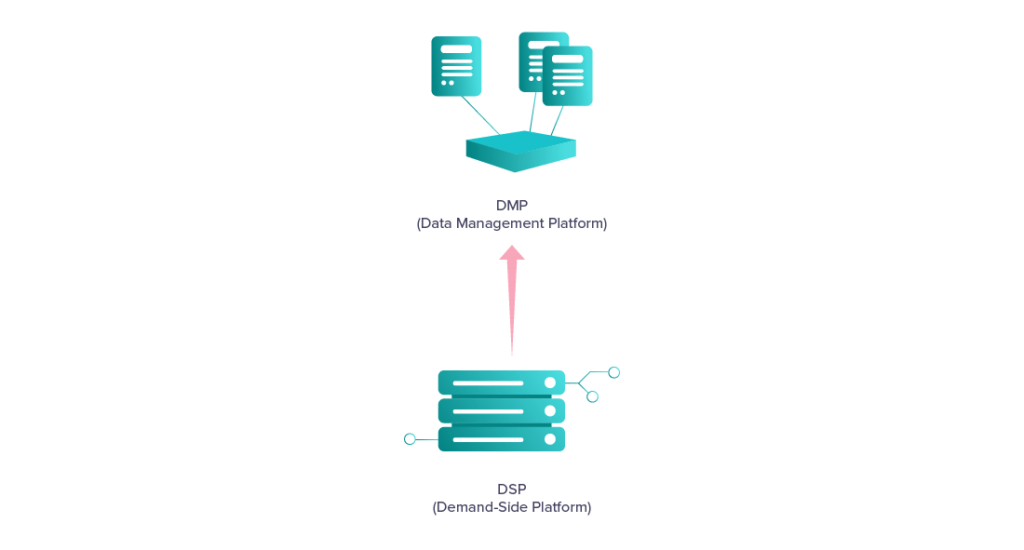
In order to properly target ads to specific
DMP vs DSP
To take full advantage of the many benefits of programmatic advertising, a Demand-Side Platform needs to be connected to a Data Management Platform.
The DSP is what handles the actual buying of ad space, whereas the DMP is used to sort data and fuel ad-buying decisions.
A DMP on its own is basically a file cabinet with information on users, and if it’s not connected to a DSP it can’t do much.
Likewise, a DSP on its own cannot make informed decisions on where to buy ad space.
They both need to exist in the ecosystem.
Many Demand Side Platforms now integrate DMP solutions directly into their tools, in order to offer advertisers a more complete solution.
Match2One is both a DSP and a DMP in one, meaning there is no need for 3rd party data management software.
The main benefit of an integrated Data Management Platform is the access you get to programmatic targeting options.
Below you’ll find more information about what kind of targeting is available with your programmatic advertising campaigns.
What is Programmatic Targeting?
There are a number of ways you can choose to target your ads with programmatic advertising, to achieve better accuracy and results.
These are the most common ways advertisers use to target their ads:
- Contextual Targeting
- Contextual targeting aims to show ads based on the context of a website. For instance; a fashion brand might choose to be seen on Vogue Magazine’s site, but a company selling financial services may have better luck with Forbes.
- Keyword Targeting
- A type of contextual targeting that focuses on serving ads based on specific keywords. For instance, if you sell bicycle spare parts you could supply a list of keywords based
around that subject. You might want to be seen in articles mentioning cycling or bicycle safety, but not motorcycle gear or electric bicycles. - Your list of keywords is matched to the keywords used in the article to provide the best match for your ads.
- A type of contextual targeting that focuses on serving ads based on specific keywords. For instance, if you sell bicycle spare parts you could supply a list of keywords based
- Data Targeting (Audience Targeting)
- Ads can also be shown based on user’s cookies rather than the context of a website – meaning that a user who’s previously visited your financial services site could be served an ad for your brand even if they’re visiting Vogue
next, since they have already shown an interest in what you’re offering.
- Ads can also be shown based on user’s cookies rather than the context of a website – meaning that a user who’s previously visited your financial services site could be served an ad for your brand even if they’re visiting Vogue
- Geo-Targeting (Location-Based Targeting or Geo-Fencing)
- Brands use geo-targeting to reach customers that are relevant to their locality. If you run a physical clothing store in Paris, it might not make sense to show ads to people who are based in Rome.
- For international brands or online services, geo-targeting can be used to serve language-specific ads tailored to audiences in a certain country.
- Retargeting
- On average 2% of visitors convert when they visit your site. Retargeting is aimed at bringing back the other 98%.
- Whenever a potential customer visits your site a cookie is placed on their computer. This information can later be used to target ads to this specific person, increasing the chances of them returning to buy from you.
- Retargeting is a highly efficient way of re-engaging people with your brand since they already have a relationship with you.
How much does programmatic advertising cost?
Programmatic is typically traded on a CPM basis, a term in online advertising defining cost per 1,000 ad impressions.
CPMs can range wildly based on the quality of the list and the level of targeting.
The higher the quality of inventory, or the more specific you want to be in your targeting, the higher the price.
Prices also vary by industry, device, format, and placement on the page.
On average, programmatic CPMs range around $0.50 to $2 CPM.
This is a huge cost benefit compared to human-driven trading, which normally sees prices around $10+.
That’s x5 the price!
So, programmatic can help you stretch your limited ad budgets 10 to 20 times further.
The low cost of programmatic offers an enormous benefit for small businesses with limited marketing budgets.
What’s next for programmatic advertising?
The final part of this article looks at the future of programmatic.
For a broader view of marketing trends in the near future, you can have a look at our top digital marketing trends for 2022.
There’s a lot happening in programmatic right now, and many ad-tech companies are taking advantage of advances in Artificial Intelligence to help marketers achieve their goals.
Above that, tools such as ChatGPT (an OpenAI product) are helping marketers with targeting ideas, banner copy, and marketing strategy ideas.
Here are some of the trends we’re seeing right now.
Self-Service Platforms
Programmatic self-service platforms make it easier for smaller brands to compete with companies with larger budgets.
Programmatic ad-tech for SMB’s is a rapidly rising trend in the advertising industry. It’s opening up a whole new dimension that’s previously been largely inaccessible for smaller companies.
In-house Revolution
With self-service platforms, brands are finding ways to take their programmatic ad buying in-house rather than going through media agencies or other middlemen.
In fact, as many as 55% of brands did their programmatic buying themselves in 2021 – and this number climbed to 72% in 2022.
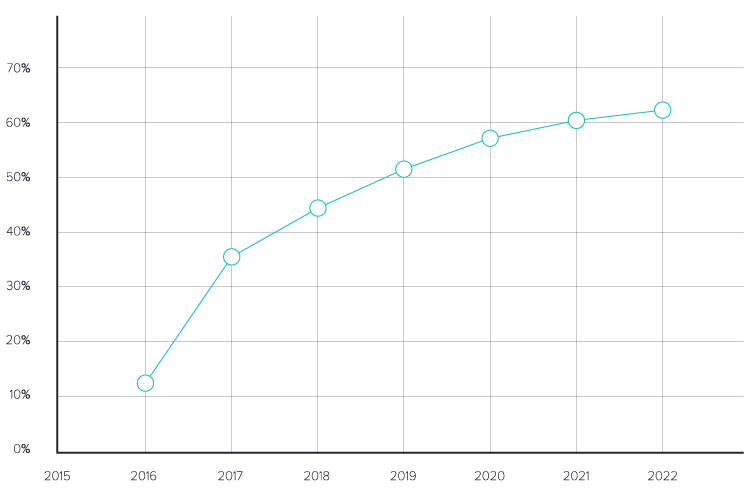
Conclusion
The future is bright for programmatic advertising and right now is an excellent time to get in on a rising trend.
Accessibility has never been better, especially for smaller brands, and hopefully, this article has given you a better view of what it’s all about.
If you’re excited to try programmatic and see what it can do for your display campaigns, Match2One is an excellent place to start!
We offer a self-service programmatic platform with no minimum spend and you can be set up with your campaign in minutes.
Just follow this link and get started today.
Are you going to try programmatic in 2023? Signup and get access to a leading programmatic platform! We’ll help you learn the ins and outs of programmatic before you go live.
Don’t forget to share this article if you know someone who might be interested in learning more about programmatic!
Leave a comment
You must be logged in to post a comment.

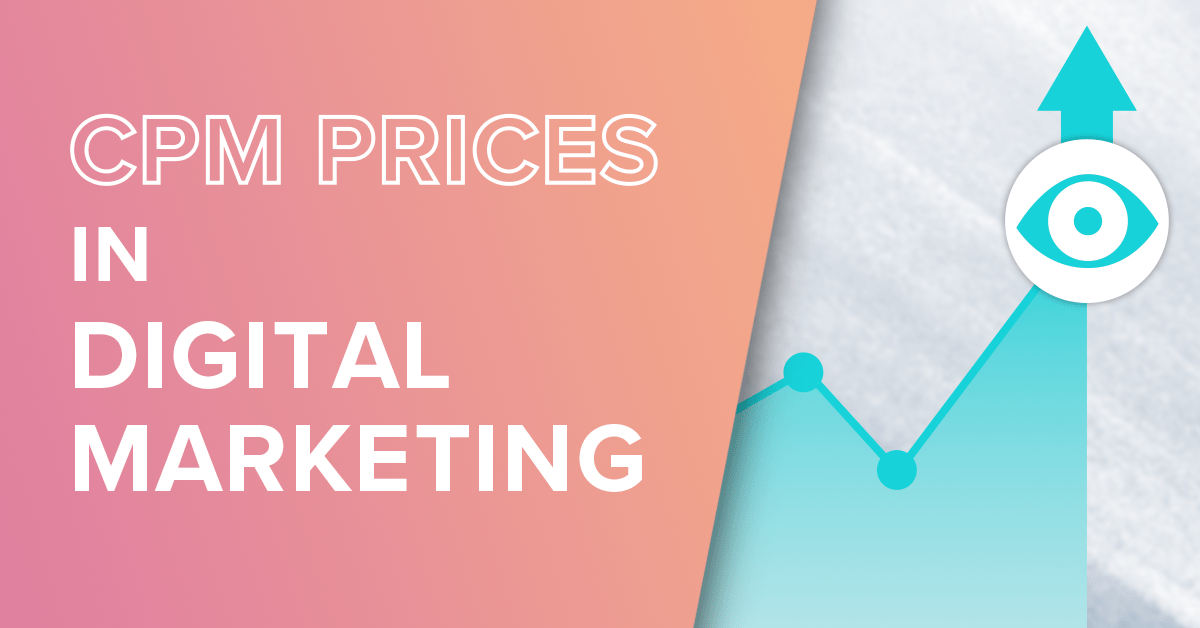

181 comments
An insightful and comprehensive guide on programmatic advertising. It provided valuable information and clarified key concepts effectively.
Nice article
VERY WELL written and I can say this as someone with ~6 years of experience in the industry. Thanks a lot for this great content! 🙂
Frankly speaking no where on Google such simple explanation is found for such complex topic.
Amazing,well elaborated . I learnt a lot
Thank you well explained
Very nicely elaborated, each point was clearly explained with example.
Thanks! just learnt loads about a word I only heard yesterday for the first time!
Amazing, detailed and well explained content… Thank you!
Perfect explanation ever. easy words, simple sentences.
Very helpful article. Explained nicely.
Very informative article. Crystal clear concepts in simple words. Loved it.
Really appreciate the content, it is unique, informatinve and great in the learing for intermediate level of paid marketing expert.
Insightful great write up!!!
This is one of the best article for understanding the fundamentals of programmatic advertising.
Simple and well explained! Thank you for taking this effort!
This is the best article to understand the concepts AdTech Frameworks and Programmatic Advertising
. I work in this industry and have gone through many such articles in the past, but none was as good as this one. Simple and information rich. Thank you writing this.
Loved this article. I am new to this industry and it gave such a good overview of basic concepts.
I read your article and need to ask how this relates to my newspaper digital media.
I wanted to know if by just selling from display ads to the native ads or page take overs, rotators including videos and maybe some geotargeting, would it be enough for agencies and advertisers to place their campaigns with my news media utilizing these formats?
This is by far the best article I have come across to learn Basics of Programmatic Advertising.
That means a lot to us. Thank you and have a great day!
Very informative, well described article! Thanks for putting it out there and sharing
Beautiful and enlightening article on programmatic. It is my first time to learn about this concept here, but i feel like i know it well now, even though practically I’m still long ways away from full comprehension. The writer is certainly a great teacher. The diagrams/visuals are very exellent and helpful.
Many thanks!!
Great article.
Programmatic combined with Coupon Ads is a killer….
As a marketing analyst I share a keen interest in this subject and while I am not an expert I found this piece to be very insightful.
Crisp and Clear .
Best article I have ever read about Programmatic Advertising. I was going through this as a career option and this article gave me the complete overview of what Programmatic Advertising is. Loved it.
This was the best article I have seen on Programmatic advertising so far. I am trying to figure out how to do it in house, and this blog post was a great start. Thanks, Match2one!
Your article is very comprehensive, I appreciate the time and effort put into this.
Have been using Appnexus / Xandr recently for CTV inventory and video and it’s been pretty good. Your blog made us make the leap of faith and it was worth it. Thank you once more!
This is a great article. Now, I am clear in all these terms of programmatic advertising. Thanks a lot.
Advertising is a marketing statement that uses non-personal contact, publicly funded to promote or sell goods, search or think. In addition, advertisement is an act of project public recognition, of high quality or analysis by means of paid announcements by an identification guarantor.
for more details, you can also visit – https://thedigizones.com/blog/
So clearly and comprehensively explained, chapeau!
Fantastic and well-explained article. Thank you!
Hi,
Good Post!. Thank you so much for sharing this post, it was so clear and easy to understand.
Awesome stuff. Please keep writing more things like this. I really like the fact you went so in depth on this and really explored the topic as much as you did. I read a lot of blogs but usually, it’s pretty shallow content. Thanks for upping the game here!
Thank you for this article.
I have been curious about UBEX AI ad platform and this article helped me to better understand, how programmatic ads working.
All information in one place – thanks again.
Rasto
Hey,
Great article.
Loved the details.
Excellent article, simple and easy to understand. Thank you
nice blog and very easy to understand your blog keep sharing these type of blogs
Brilliant! Loved the way you explained.
Congrats to your post. You explained it very easy
This is a brilliant piece of explanation and was really helpful to gain some basic insight on how things work in a digital environment . It clearly indicates that there is more bang to your advertising media buck in the Digital arena
Ola, this is honestly one of the most informative articles we’ve ever read on programmatic and it broke out every aspect in lamens terms, especially why DMPs and so important in the cycle. We knew of the importance of the DMP on the buy side, but never on the sell side, so this was a good note to include.
If we had to include one thing in this model, it’s the consideration of programmatic direct vs. direct ad buys and how they fit in (although that might complicate things). Even with the rise of programmatic and all it’s wonderful excellence, there still is a market for direct ad buys with major publishers for premium inventory.
As a digital agency for smaller fashion brands, direct buys are out of reach, but if there was an opportunity to have premium pre-bid inventory on large sites like Vogue or Runway at programmatic type budgets, we would not pass that by.
Hi,
Thank you for the great comments!
I appreciate the note about direct ad buys. It gave me some ideas for a follow-up to this article 🙂
Match2One was actually founded exactly because of what you’re describing – for companies who don’t have access to direct-buy. Our platform has access to premium inventory like Elle and Vogue, no matter which budget you’re on.
We’d love to help you get set up if you’re interested. Just reach out in the chat and someone will be in touch 🙂
Thanks and happy holidays!
Very well explained. Nice and Informative Article.
Nice and Informative Article
Very informative and simple explanation to a complex topic. Thank you very much for posting this.
Thanks for sharing good .
Wow, amazing I saw the article with execution models you had posted. It was such informative. Really it is a wonderful article. Thank you for sharing and Please keep update like this type of article because I want to learn more relevant to this topic.
woah.. i didnt have any idea about these.. display screens is innovative and this article is helpful.
Hi!
I literally had wonderful time reading all of these details.
Good Post! Thank you so much for sharing this pretty post, it was so good to read and useful to improve my knowledge about video advertisement.